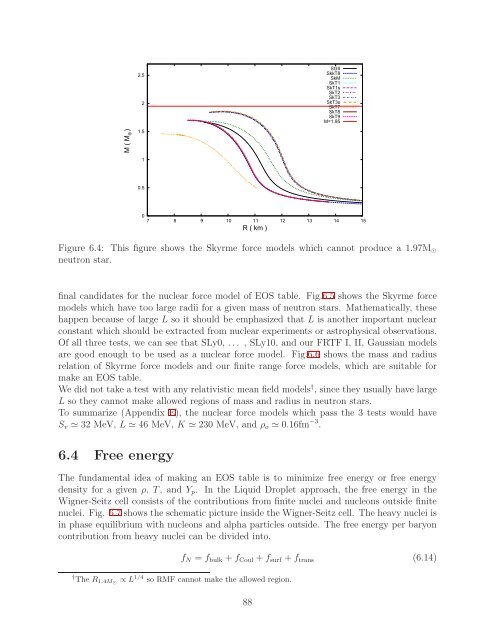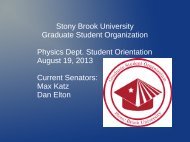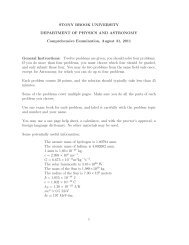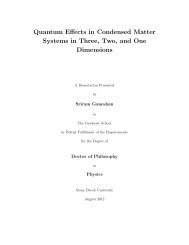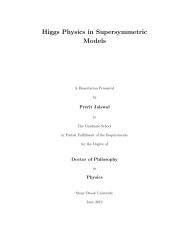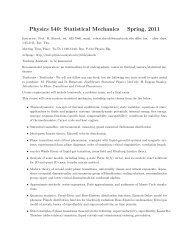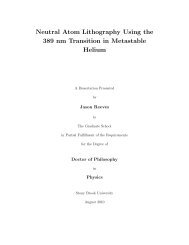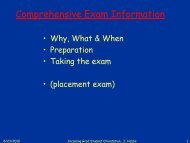Theory of Nuclear Matter for Neutron Stars and ... - Graduate Physics
Theory of Nuclear Matter for Neutron Stars and ... - Graduate Physics
Theory of Nuclear Matter for Neutron Stars and ... - Graduate Physics
You also want an ePaper? Increase the reach of your titles
YUMPU automatically turns print PDFs into web optimized ePapers that Google loves.
2.52SGIISkkT8SkMSkT1SkT1sSkT2SkT3SkT3sSkT7SkT8SkT9M=1.95M ( M O•)1.510.507 8 9 10 11 12 13 14 15R ( km )Figure 6.4: This figure shows the Skyrme <strong>for</strong>ce models which cannot produce a 1.97M ⊙neutron star.final c<strong>and</strong>idates <strong>for</strong> the nuclear <strong>for</strong>ce model <strong>of</strong> EOS table. Fig.6.5 shows the Skyrme <strong>for</strong>cemodels which have too large radii <strong>for</strong> a given mass <strong>of</strong> neutron stars. Mathematically, thesehappen because <strong>of</strong> large L so it should be emphasized that L is another important nuclearconstant which should be extracted from nuclear experiments or astrophysical observations.Of all three tests, we can see that SLy0, ... , SLy10, <strong>and</strong> our FRTF I, II, Gaussian modelsare good enough to be used as a nuclear <strong>for</strong>ce model. Fig.6.6 shows the mass <strong>and</strong> radiusrelation <strong>of</strong> Skyrme <strong>for</strong>ce models <strong>and</strong> our finite range <strong>for</strong>ce models, which are suitable <strong>for</strong>make an EOS table.We did not take a test with any relativistic mean field models † , since they usually have largeL so they cannot make allowed regions <strong>of</strong> mass <strong>and</strong> radius in neutron stars.To summarize (Appendix E), the nuclear <strong>for</strong>ce models which pass the 3 tests would haveS v ≃ 32 MeV, L ≃ 46 MeV, K ≃ 230 MeV, <strong>and</strong> ρ o ≃ 0.16fm −3 .6.4 Free energyThe fundamental idea <strong>of</strong> making an EOS table is to minimize free energy or free energydensity <strong>for</strong> a given ρ, T, <strong>and</strong> Y p . In the Liquid Droplet approach, the free energy in theWigner-Seitz cell consists <strong>of</strong> the contributions from finite nuclei <strong>and</strong> nucleons outside finitenuclei. Fig. 6.7 shows the schematic picture inside the Wigner-Seitz cell. The heavy nuclei isin phase equilibrium with nucleons <strong>and</strong> alpha particles outside. The free energy per baryoncontribution from heavy nuclei can be divided into,f N = f bulk +f Coul +f surf +f trans (6.14)† The R 1.4M⊙ ∝ L 1/4 so RMF cannot make the allowed region.88


